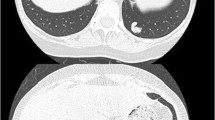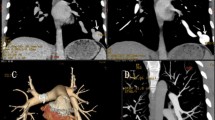Abstract
Background. It has been suggested that tungsten coils (TCs) may corrode 30 months after transcatheter embolisation (TCE). The aim of this study was to follow up children after TCE of aorto-pulmonary collaterals (APCs) with TCs.
Materials and methods. Successful TCE of 99 APCs was performed in children using 152 TCs. Chest radiographs were obtained on the day after the procedure, after 3–6 months and 9–12 months, and yearly thereafter.
Results. Mean follow-up was 39.3 months. After 9–12 months, radiographs revealed a decrease in radio-opacity and reduction of coil width in 29 (37.6%) of 77 APCs. After a mean of 25 months (range 13–51 months), there was loss of visibility in 44 (57.2%) of 77 TCs and a reduction in 29 (37.6%) of 77. After a mean of 39.3 months, all TCs showed decrease or loss of radio-opacity. Exponential function predicts complete biodegradation of 95% of TCs within 10 years after TCE (r2=0.923). After a mean of 28.4 months, repeat catheterisation was performed in 24 APCs with TCs with decreased or lost radio-opacity. Recanalisation had occurred in 58.3%.
Conclusions. Dissolution occurred in 57.2% of TCs within a mean of 25 months, and within 39.3 months all TCs showed decrease or loss of radio-opacity. Recanalisation of closed APCs occurred in 58.3%.
Similar content being viewed by others
Author information
Authors and Affiliations
Additional information
Electronic Publication
Rights and permissions
About this article
Cite this article
Kampmann, C., Brzezinska, R., Abidini, M. et al. Biodegradation of tungsten embolisation coils used in children. Ped Radiol 32, 839–843 (2002). https://doi.org/10.1007/s00247-002-0825-1
Received:
Accepted:
Issue Date:
DOI: https://doi.org/10.1007/s00247-002-0825-1




